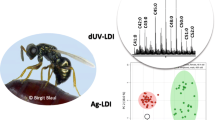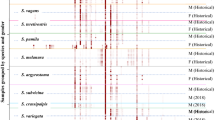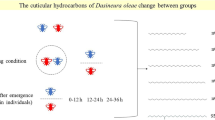Abstract
Cuticular hydrocarbons (CHCs) are the main components of the epicuticular wax layer that in many insects functions as a barrier against desiccation. CHCs also play many other roles, including serving as sex pheromones, kairomones, primer pheromones, and colony-, caste-, species- and sex-recognition signals. In insects, CHC profiles can vary depending upon age, species, sex, and strain. Understanding factors associated with variation in hydrocarbon profiles is important for identifying potential vulnerabilities relating to pest ecology and life histories and for developing tools for pest monitoring and management strategies. In this study, we assessed potential sources of variation in CHC profiles in the navel orangeworm Amyelois transitella (Walker) (Lepidoptera: Pyralidae), an economically important pest of nut crops in California. Using coupled gas chromatography-mass spectrometry, we characterized and compared CHC profiles between adults of pyrethroid-resistant (R347) and susceptible (ALMOND) strains. We further compared CHC profiles from adults differing in age (1, 3, 5, and 7 d post-eclosion) and sex. Hydrocarbon profiles comprised 47 different CHCs in detectable quantities that ranged from C17 to C43 in chain length and included straight-chain alkanes and a variety of mono-, di-, and tri-methylalkanes. Adults from resistant populations had greater quantities of CHCs in total than those from susceptible strains, but relative quantities of individual components were similar. The six most abundant compounds were n-pentacosane, n-heptacosane, n-nonacosane, n-hentriacontane, 11,25 + 13,23 + 15,21-dimethylpentatriacontane, and 13,23 + 11,25 + 9,17-dimethylheptatriacontane. Post-eclosion, total CHCs increased with adult age, with males producing greater quantities than females at all ages. Our results show that CHC profiles vary depending on age, sex, and strain and suggest that CHC profiles may be useful as biomarkers to differentiate between insecticide- resistant and susceptible populations.




Similar content being viewed by others
Change history
04 February 2020
The original version of this article unfortunately contained a mistake. When filing the final publication details, we failed to include the following statement in our Acknowledgments paragraph: We thank the Almond Board of California for research funding.
04 February 2020
The original version of this article unfortunately contained a mistake. When filing the final publication details, we failed to include the following statement in our Acknowledgments paragraph: We thank the Almond Board of California for research funding.
References
Ahmad M, Denholm I, Bromilow RH (2006) Delayed cuticular penetration and enhanced metabolism of deltamethrin in pyrethroid-resistant strains of Helicoverpa armigera from China and Pakistan. Pest Manag Sci 62:805–810
Andersen SO (2005) Cuticular sclerotization and tanning. In: Gilbert LI, Latrou K, gill SS (eds.) comprehensive molecular insect science, vol. 4. Elsevier-Pergamon, pp 145-175
Andersen SO (2010) Insect cuticular sclerotization: a review. Insect Biochem Mol Biol 40:166–178
Balabanidou V, Kampouraki A, MacLean M, Blomquist GJ, Tittiger C, Juarez MP, Mijailovsky SJ, Chalepakis G, Anthousi A, Lynd A, Antoine S, Hemingway J, Ranson H, Lycett GJ, Vontas J (2016) Cytochrome P450 associated with insecticide resistance catalyzes cuticular hydrocarbon production in Anopheles gambiae. Proc Natl Acad Sci U S A 113:9268–9273
Balabanidou V, Kefi M, Aivaliotis M, Koidou V, Girotti JR, Mijailovsky SJ, Juarez MP, Papadogiorgaki E, Chalepakis G, Kampouraki A, Nikolaou C, Ranson H, Vontas J (2019) Mosquitoes cloak their legs to resist insecticides. Proc Royal Soc B 286:20191091
Blomquist GJ, Bagnères AG (2010) Insect hydrocarbons: biology, biochemistry, and chemical ecology. Cambridge University Press, Cambridge
Burks CS, Higbee B, Beck J (2018) Comparison of monitoring techniques in and near almonds and pistachios under mating disruption treatment for navel orangeworm. Acta Hortic 1219:331–338
Bush DS, Siegel JP, Berenbaum MR (2018) Accelerated development and toxin tolerance of the navel orangeworm Amyelois transitella (Lepidoptera: Pyralidae) in the presence of Aspergillus flavus. J Chem Ecol 44:1170–1177
Carlson DA, Bernier UR, Sutton BD (1998) Elution patterns from capillary GC for methyl-branched alkanes. J Chem Ecol 24:1845–1865
Chen N, Pei XJ, Fan YL, Liu TX (2019) Involvement of integument-rich CYP4G19 in hydrocarbon biosynthesis and cuticular penetration in Blatella germanica (L.) Pest Manag Sci https://doi.org/10.1002/ps.5499
Connell JH (2002) Leading edge of plant protection for almond. Hort Technol 12:619–622
Curtis RK, Barnes MM (1977) Oviposition and development of the navel orangeworm inrelation to almond maturation. J. Econ Entomol 70:395–398
Dapporto L (2007) Cuticular lipid diversification in Lasiommata megera and Lasiommata paramegaera: the influence of species, sex and population (Lepidoptera: Nymphalidae). Biol J Linn Soc 91:703–710
Demkovich M (2019) Identifying mechanisms of pyrethroid resistance in the navel orangeworm and novel methods of control. PhD dissertation, University of Illinois at Urbana-Champaign, Urbana, IL
Demkovich M, Dana CE, Siegel JP, Berenbaum MR (2015a) Effect of piperonyl butoxide on the toxicity of four classes of insecticides to navel orangeworm (Amyelois transitella) (Lepidoptera: Pyralidae). J Econ Entomol 108:2753–2760
Demkovich M, Siegel JP, Higbee BS, Berenbaum MR (2015b) Mechanism of resistance acquisition and potential associated fitness costs in Amyelois transitella (Lepidoptera: Pyralidae) exposed to pyrethroid insecticides. Environ Entomol 44:855–863
de Renobales M, Blomquist GJ (1983) A developmental study of the composition and biosynthesis of the cuticular hydrocarbons of Trichoplusia ni (Lepidoptera: Noctuidae). Insect Biochem 13:493–502
Espelie KE, Brown JJ (1990) Cuticular hydrocarbons of species which interact on four trophic levels: apple, Malus pumila mill.; codling moth Cydia pomonella L.; a hymenopteran parasitoid, Ascogaster quadridentata Wesmael; and a hyperparasite, Perilampus fulvicornis Ashmead. Comp Biochem Physiol 95B:131–136
Ferveur JF (2005) Cuticular hydricarbons: their evolution and roles in Drosophila during courtship and mating. Behav Genet 35:279–295
Finney GL, Brinkman D (1967) Rearing the navel orangeworm in the laboratory. J Econ Entomol 60:1109–1111
Foley BR, Telonis-Scott M (2011) Quantitative genetic analysis suggests causal association between cuticular hydrocarbon composition and desiccation survival in Drosophila melanogaster. Heredity 106:68–77
Gibbs AG (1998) Water-proofing properties of cuticular lipids. Integr Comp Biol 38:471–482
Gibbs AG, Markow TA (2001) Effects of age on water balance in Drosophila species. Physiol Biochem Zool 74:520–530
Girotti JR, Mijailovsky SJ, Juarez MP (2012) Epicuticular hydrocarbons of the sugarcane borer Diatraea saccharalis (Lepidoptera: Crambidae). Physiol Entomol 37:266–277
Guo L, Blomquist GJ (1991) Identification, accumulation and biosynthesis of the cuticular hydrocarbons of the southern armyworm, Spodoptera eridania Cramer (Lepidoptera: Noctuidae). Archives Insect Biochem Physiol 16:19–30
Hadley NF (1981) Cuticular lipids of terrestrial plants and arthropods: a comparison of their structure, composition, and waterproofing function. Biol Rev 56:23–47
Heinrich C (1956) American moths of the subfamily Phycitinae. U.S. National Museum Bulletin. The Smithsonian Institution, Washington, DC, pp 1–581
Heuskin S, Vanderplanck M, Bacquet P, Holveck MJ, Kaltenpoth M, Engl T, Pels C, Taverne C, Lognay G, Nieberding CM (2014) The composition of cuticular compounds indicates body parts, sex and age in the model butterfly Bicyclus anynana (Lepidoptera). Frontiers Ecol Evol 37:1–16
Higbee BS, Burks CS, Cardé RT (2017) Mating disruption of the navel orangeworm (Lepidoptera: Pyralidae) using widely spaced, aerosol dispensers: is the pheromone blend the most efficacious disruptant? J. Econ Entomol 110:2056–2016
Howard RW (1993) Cuticular hydrocarbons and chemical communication. In: Stanley-Samuelson DW, Nelson DR (eds) Insect lipids. University of Nebraska Press, Lincoln, pp 177–226
Howard RW, Baker JE (2004) Stage-specific surface chemicals of Plodia interpunctella: 2-acyl-1,3-cyclohexanediones from larval mandibular glands serve as cuticular lipids. Comp Biochem Physiol B 138:193–206
Howard RW, Blomquist GJ (2005) Ecological, behavioral, and biochemical aspects of insect hydrocarbons. Annu Rev Entomol 50:371–393
Ingham VA, Jones CM, Pignatelli P, Balabanidou V, Vontas J, Wagstaff SC, Moore JD, Ranson H (2014) Dissecting the organ specificity of insecticide resistance candidate genes in Anopheles gambiae: known and novel candidate genes. BMC Genomics 15:1018
Kefi M, Balabanidou V, Douris V, Lycett G, Feyereisen R (2019) Two functionally distinct CYP4G genes of Anopheles gambiae contribute to cuticular hydrocarbon biosynthesis. Insect Biochem Mol Biol 110:52–59
Kuenen LPS, McElfresh JS, Millar JG (2010) Identification of critical secondary components of the sex pheromone of the navel orangeworm (Lepidoptera: Pyralidae). J Econ Entomol 103:314–330
Leal WS, Parra-Pedrazzoli AL, Kaissling KE, Morgan TI, Zalom FG, Pesak DJ, Dundulis EA, Burks CS, Higbee BS (2005) Unusual pheromone chemistry in the navel orangeworm: novel sex attractants and a behavioral antagonist. Naturwissenschaften 92:139–146
Lin Y, Jin T, Zeng L, Lu Y (2012) Cuticular penetration of β-cypermethrin in insecticide-susceptible and resistant strains of Bactrocera dorsalis. Pest Biochem Physiol 103:189–193
NASS (2017) California Almond Acreage Report. (http:nass.usda.gov/ca) ()
Nelson DR, Buckner JS (1995) The surface hydrocarbons of larval Heliothis virescens and Helicoverpa zea. Comp Biochem Physiol 111B:681–689
Noppun V, Saito T, Miyata T (1989) Cuticular penetration of S-fenvalerate in fenvalerate-resistant and susceptible strains of the diamondback moth, Plutella xylostella (L.). Pesticide Biochem Physiol 33:83–87
Palumbo JD, Mahoney NE, Light DM, Siegel J, Puckett RD, Michailides TJ (2014) Spread of Aspergillus flavus by navel orangeworm (Amyelois transitella) on almond. Plant Dis 98:1194–1199
Piskorski R, Trematerra R, Dorn S (2010) Cuticular hydrocarbon profiles of codling moth larvae, Cydia pomonella (Lepidoptera: Tortricidae), reflect those of their host plant species. Biol J Linn Soc 101:376–384
Puinean AM, Foster SP, Oliphant L, Denholm I, Field LM, Millar NS, Williamson MS, Bass C (2010) Amplification of a cytochrome P450 gene is associated with resistance to neonicotinoid insecticides in the aphid Myzus persicae. PLoS Genet 6:e1000999
Scholtens BG, Solis MA (2015) Annotated check list of the Pyraloidea (Lepidoptera) of America north of Mexico. Zookeys 535:1–136
Smith AA, Millar JG, Suarez AV (2016) Comparative analysis of fertility signals and sex-specific cuticular chemical profiles of Odontomachus trap-jaw ants. J Exp Biol 219:419–430
Strycharz JP, Lao A, Li H, Qiu X, Lee SH, Sun W, Yoon KS, Doherty JJ, Pittendrigh BR, Clark JM (2013) Resistance in the highly DDT-resistant 91-R strain of Drosophila melanogaster involves decreased penetration, increased metabolism, and direct excretion. Pesticide Biochem Phys 107:207–217
Wang S, Li B, Zhang D (2019a) NICYP4G76 and NICYP4G115 modulate susceptibility to desiccation and insecticide penetration through affecting cuticular hydrocarbon biosynthesis in Nilaparvata lugens (Hemiptera: Delphacidae). Front Physiol 10:913
Wang SY, Price JH, Zhang D (2019b) Hydrocarbons catalyzed by TmCYP4G122 and TmCYP4G123 in Tenebrio molitor modulate the olfactory response of the parasitoid Scleroderma guani. Insect Mol Biol 28:637–648
Wigglesworth VB (1988) The source of lipids and polyphenols for the insect cuticle: the role of fatbody, oenocytes and oenocytoids. Tissue & Cell 20:919–932
Wood O, Hanrahan S, Coetzee M, Koekemoer L, Brooke B (2010) Cuticle thickening associated with pyrethroid resistance in the major malaria vector Anopheles funestus. Parasit Vectors 3:67–73
Xiao W, Matsuyama S, Ando T, Millar JG, Honda H (2012) Unsaturated cuticular hydrocarbons synergize responses to sex attractant pheromone in the yellow peach moth, Conogethes punctiferalis. J Chem Ecol 38:1143–1150
Yahouédo GA, Chandre F, Rossignol M, Ginibre C, Balabanidou V, Mendez NGA, Pigeon O, Vontas J, Cornelie S (2017) Contributions of cuticle permeability and enzyme detoxification to pyrethroid resistance in the major malaria vector Anopheles gambiae. Sci Rep 7:11091
Zalom FG, Pickle C, Bentley WG, Haviland DR, Van Steenwyk RA, Rice RE, Hendricks LC, Coviello RL, Freeman MW (2012) UC IPM pest management guidelines: almond. Publ 3431, University of California ANR
Acknowledgments
We thank Mark Demkovich for assistance with the insect colonies and for reviewing early drafts of the manuscript. We also thank Liqun Zeng and Daniel Bush for assistance with data analysis, and Judy Mongold-Diers and Jodie Ellis for assisting with the GC-MS analyses. We thank Joel Siegel for technical advice.
Author information
Authors and Affiliations
Corresponding author
Electronic supplementary material
Supplemental Table 1
EFFECT OF AGE ON THE COMPOSITION OF CUTICULAR HYDROCARBONS IN PYRETHROID-RESISTANT (R347) AND SUSCEPTIBLE (ALMOND) NAVEL ORANGEWORM STRAINS. Values represent mean total cuticular hydrocarbons ± SD of 10 adults. (XLSX 15 kb)
Supplemental Table 2
EFFECT OF SEX ON THE COMPOSITION OF CUTICULAR HYDROCARBONS IN PYRETHROID-RESISTANT (R347) AND SUSCEPTIBLE (ALMOND) NAVEL ORANGEWORM STRAINS. Values represent mean total cuticular hydrocarbons ± SD of 10 adults. (XLSX 15 kb)
Rights and permissions
About this article
Cite this article
Ngumbi, E.N., Hanks, L.M., Suarez, A.V. et al. Factors Associated with Variation in Cuticular Hydrocarbon Profiles in the Navel Orangeworm, Amyelois transitella (Lepidoptera: Pyralidae). J Chem Ecol 46, 40–47 (2020). https://doi.org/10.1007/s10886-019-01129-6
Received:
Revised:
Accepted:
Published:
Issue Date:
DOI: https://doi.org/10.1007/s10886-019-01129-6




